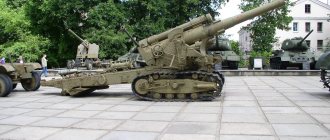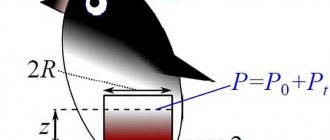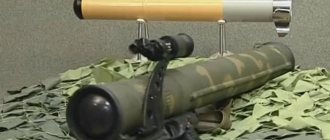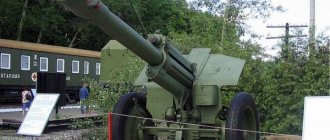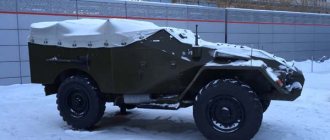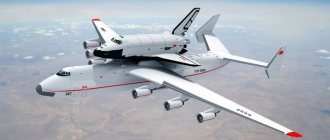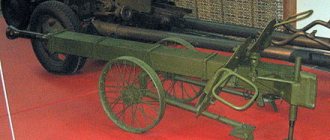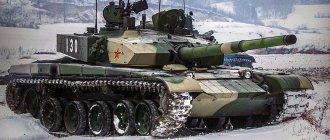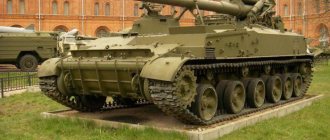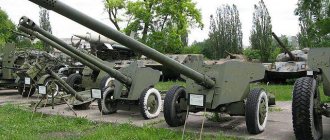| D-44 | |
| Type | Divisional and anti-tank gun |
| A country | USSR USSR |
| Service history | |
| Years of use | 1946-present |
| Adopted | 1946 |
| In service | USSR |
| Production history | |
| Constructor | F. F. Petrov |
| Designed by | 1944 |
| Manufacturer | Plant No. 9 |
| Years of production | 1946—1954 |
| Total issued | 10918 |
| Options | SD-44; Type 54 (China) |
| Characteristics | |
| Weight, kg | 1.725 t |
| Length, mm | 8.34 meters |
| Barrel length, mm | 55.1 caliber |
| Width, mm | 1.68 meters (stowed position) |
| Crew (crew), people. | 7 |
| Caliber, mm | 85 |
| Elevation angle | -7° — +35° |
| Angle of rotation | 54° |
| Rate of fire, rounds/min | 20-25 |
| Initial projectile speed, m/s | 793 |
| Maximum range, m | 15820 meters |
| Aim | S71-7, OP2-7, OP4-7, OP4M-7, APN-2, APN3-7 |
| D-44 at Wikimedia Commons | |
The 85-mm divisional gun D-44
is a Soviet artillery gun.
Developed in the design bureau) under the leadership of chief designer F.F. Petrov in the second half of 1944, after a number of modifications, it passed the state. tests.
It was put into service in 1946. From 1946 to 1954, 10,918 guns were manufactured.
Story
The gun was developed by the design bureau of plant No. 8 in Kaliningrad near Moscow on the instructions of the State Autonomous Agrarian University. Its predecessor was the 76-mm anti-aircraft gun of the 1938 model created by M. N. Loginov, which was produced in a small series in 1938-1940. Due to the extremely short time frame allocated for the development of the new system, leading designer G.D. Dorokhin decided to put an 85-mm barrel on the platform of a 76-mm anti-aircraft gun of the 1938 model, using the bolt and semi-automatic mechanism of this gun. In 1939, a new 85-mm anti-aircraft gun with the factory designation 52-K underwent field tests, during which it was revealed that it was necessary to install a muzzle brake, increase the supporting surface of the bolt wedge and the breech socket. The weapon, modified in accordance with the recommendations of the scientific testing site, was adopted by the Red Army in the same year under the name “85-mm anti-aircraft gun model 1939.”[1]
At the beginning of the war, there were 3,082 guns available (3,016 in the Red Army and 66 in the Navy).
To increase the accuracy of firing at air targets, batteries of 85-mm anti-aircraft guns were equipped with PUAZO-3 artillery anti-aircraft fire control devices, which made it possible to solve the problem of meeting a projectile and an aircraft. In addition to the PUAZO devices, RUS detection radar stations were also used to control the fire of the 85-mm anti-aircraft gun units operating in the main directions. The gun was also equipped with a mechanical fuze installer designed by L. V. Lyulev.[1]
In order to increase the production of anti-aircraft artillery during the war, it was necessary to solve the problem of reducing the labor and metal intensity of products. The design of the 52-K gun was simplified, and at the same time its manufacturing technology was improved. In 1943, the improved gun was successfully tested, and in February 1944, the gun, which received the factory designation KS-12, went into mass production. The first two letters of the index meant that the gun was created at the plant named after. Kalinin in Sverdlovsk.[1]
Designed to combat enemy aircraft, to fire at airborne assault forces, at live ground targets and enemy firing points, these guns were also successfully used to destroy fascist tanks. The 52-K coped with an unusual task for an anti-aircraft gun more successfully than other anti-tank guns of those years. With an armor-piercing projectile attached to it, it could penetrate the armor of all types of tanks that were in service with the German army until mid-1943. And when in 1942 G.D. Dorokhin was awarded the title of State Prize laureate, the award noted not only the anti-aircraft, but also the anti-tank qualities of the gun.[1]
History of creation
The project of a self-propelled gun based on the D-44 was developed at OKB-9 by the end of 1948, and on January 1, 1949 it was sent to the Ministry of Armaments. The Ministry of Armaments approved the project, and the plant began manufacturing a prototype of the weapon. In the first quarter of 1950, the first prototype was ready. In the period from 1951 to 1952, the gun underwent factory tests, and then was sent to the Moscow region for field tests. Based on the test results, a number of defects and comments were identified, after elimination of which an installation batch of a battery of guns was manufactured. In 1954, three guns from the pilot batch were sent for military testing, after which on November 19, 1954, by decree of the Council of Ministers of the USSR, the SD-44 self-propelled gun was adopted by the Soviet Army [1].
Production
Production of 52-K guns (RGVA, TsAMO)
| Manufacturer | 1939 | 1940 | 1941 | 1942 | 1943 | 1944 | 1945 | Total |
| No. 8 (Kaliningrad) | 20 | 940 | 3319 | 4279 | ||||
| No. 8 (Sverdlovsk) | 52 | 2761 | 3715 | 1903 | 712 | 16992 | ||
| Total | 20 | 960 | 3371 | 2761 | 3715 | 1903 | 712 | 21271 |
Production of 52-K guns in 1941 (TsAMO)
| Manufacturer | 1st half of the year | July | August | September | October | november | December | Total |
| No. 8 (Kaliningrad) | 1670 | 449 | 500 | 500 | 200 | 3319 | ||
| No. 8 (Sverdlovsk) | 52 | 52 | ||||||
| Total | 1670 | 449 | 500 | 500 | 200 | 52 | 3371 |
D-5-S-85BM and D-5-T-85BM
At the end of 1943, the GAU turned to the design bureau of plant No. 9 with a proposal to develop an anti-tank gun with ballistics similar to the ballistics of the German 88-mm KwK 43 tank gun. The modernized D-5 gun received a longer barrel, which made it possible to increase the muzzle velocity of the armor-piercing projectile to 920— 950 m/s due to an increase in the powder charge. At the same time, the gun could fire with conventional 85 mm ammunition.
The version of the gun intended for installation in a tank turret received the index D-5-T-85BM (BM - high power), and the version intended for installation in the wheelhouse of a self-propelled gun received the index D-5-S-85BM.
The prototype D-5-S-85BM was installed in the hull of the serial self-propelled gun SU-85, and the prototype D-5-T-85BM was installed in the IS-85 tank. The experimental self-propelled gun was designated SU-85BM, and the IS-85 tank was designated Object 244. After field tests that took place from January to March 1944, none of the vehicles were accepted for service.
Characteristics and properties of ammunition
- Loading: unitary
- Ammunition range: Anti-aircraft fragmentation grenade with remote fuse T-5, TM-30, VM-30: 53-UO-365.
- Anti-aircraft fragmentation grenade with remote fuse VM-2: 53-UO-365,
- Anti-aircraft fragmentation grenade with adapter head and fuse KTM-1: 53-UO-365
- Armor-piercing tracer caliber projectile 53-UBR-365
- Armor-piercing tracer pointed-head caliber projectile 53-UBR-365K
- Armor-piercing tracer sub-caliber projectile 53-UBR-365P
- Anti-aircraft fragmentation grenade with T-5: 800
- Armor-piercing caliber: 9.2
- Meeting angle relative to the tangent plane to the armor 60 degrees Distance 100 m: 100
- Distance 100 m: 120
Divisional gun D-44 in Kazarovo
Published by: dokaspez, 11-02-2016, 18:51, Equipment and weapons, 1,651, 0
In the Pogranichnikov park (Kazarovo village, Tyumen) at the exhibition of artillery systems - the rightmost gun in the row - 85 mm D-44 divisional gun
At the final stage of the Second World War, a need arose for a more powerful divisional gun than the
76-mm ZIS-3 gun.
Various design bureaus have proposed several options for new guns designed to destroy engineering structures and enemy personnel, destroy armored vehicles and long-term firing points.
In particular, Design Bureau) under the leadership of chief designer F.F. Petrova in the second half of 1944 designed the 85-mm D-44 divisional gun. A prototype of the ZIS-D-44 cannon (barrel length - 4675 mm / 55.1 klb, cannon weight - 1630 kg) was manufactured at plant No. 92 named after. Stalin. At the beginning of 1945, this gun passed field tests. According to the conclusion of the commission, the ZIS-D-44 did not pass these tests, including due to unsatisfactory extraction of cartridges. The gun was modified at Plant No. 9 and sent for repeated testing on May 8, 1945. The shooting began at the Gorokhovets training ground on May 10. Here the gun showed a maximum rate of fire of 20-22 rounds per minute (without aiming correction). Run-in tests were carried out with a Studebaker car, and off-road tests with a Y-12 tractor. After military tests, the gun was put into service in 1946 under the name “85-mm divisional gun D-44.”
One of its main creators is N.G.
Kostrulin, was awarded the Stalin Prize 1st degree. Technical characteristics of the D-44 anti-tank gun:
Show / Hide text
Caliber - 85 millimeters;
Barrel length - 4685 millimeters (55 calibers); The length of the rifled part of the barrel is 3496 millimeters (41 calibers); Number of grooves – 24; The volume of the charging chamber with a 0-365K fragmentation projectile is 3.94 dm3; The height of the firing line is 825 mm; Vertical guidance angle – -7° +35°; Horizontal guidance angle – 54°; System length – 8340 millimeters; The height of the firing line is 825 millimeters; Width – 1680 millimeters; Height – 1420 millimeters; Ground clearance - 350 millimeters; Track width - 1434 millimeters; Weight in combat position - 1725 kilograms; Barrel with bolt - 718 kilograms; Shutter - 31.6 kilograms; Swinging part - 920 kilograms; Recoil parts (barrel with recoil devices and bolt) - 785 kilograms; Cradles - 99 kilograms; Assembled rollback brakes – 42 kilograms; Assembled knurling – 32 kilograms; Balancing mechanism – 13 kilograms; Assembled upper machine – 71 kilograms; Assembled shield cover - 83 kilograms; Assembled lower machine – 133 kilograms; Hobby roller - 12.3 kilograms; Wheels (with hub) – 81 kilograms; Chassis (wheels, suspension and combat axle) - 222 kilograms; Assembled carriage - 972 kilograms: Ski installation - 170 kilograms; Transfer from combat to traveling position – 1 minute; The target rate of fire of the gun is 10-15 rounds per minute; The maximum rate of fire of the gun is 20 rounds per minute; Transportation speed on good roads is 60 km/h; Transportation speed on cobblestone roads is 35 km/h; Off-road transportation speed is 15 km/h. Calculation – 5 people. The D-44 cannon
is made according to the classic design of an artillery gun; its distinctive features are the compact placement of guidance mechanisms, a low height of the firing line and the ability to be transported by mechanical traction at a speed of up to 60 km/h.
The time it takes to transfer the gun from the traveling position to the combat position and back does not exceed one minute. The barrel of the serial D-44 cannon (factory designation 52-P-367) consisted of a monoblock pipe, breech, coupling, muzzle brake and clip. The muzzle brake is of the active type. The recoil brake is hydraulic. Recoil devices are placed in a clip above the barrel; when fired, they roll back with it. The normal rollback length is 580-660 mm, the maximum length is 675 mm. The shutter is a vertical wedge with semi-automatic mechanical (copier) type. The cradle was a cast cylindrical frame mounted on the upper machine of the carriage. A lifting mechanism is also mounted on it. The rotating mechanism is screw type. The balancing mechanism is a pusher type, with hydraulic air lock; it consisted of one column located to the left of the barrel. Sights: panoramic sight M71-7 or mechanical sight - S71-7, optical sights OP1-7, OP2-7, OP4-7 or OP4M-7. To protect the crew from small arms bullets and fragments of artillery shells and mines, a shield cover is attached to the upper machine of the carriage. The lower carriage machine is equipped with two sliding tubular frames. The chassis is two-wheeled. Wheels - size 6.50-20 from a GAZ-AA truck, with a GK tire (filled with sponge rubber). The combat axle consisted of two straight axle shafts. The gun's suspension is torsion bar. Ammunition for the D-44 anti-tank gun:
Show / Hide text
UO-367 and UO-365K rounds
consist of a steel solid-body fragmentation projectile 0-365K, a head fuse, a steel (brass) cartridge case, a KV-4 primer sleeve is screwed into its bottom part, and a powder charge (UO-365K has a full and UO-367 reduced charge).
UO-367A
consists of a 0-367A projectile (solid-body fragmentation steel cast iron), a head fuse, a steel (brass) sleeve, a KV-4 primer sleeve is screwed into the bottom part and a reduced combat powder charge.
The UBR-365K
consists of a BR-365K projectile (sharp-headed armor-piercing tracer), an MD-8 fuse with a tracer screwed into the bottom part, a steel (brass) sleeve, a KV-4 primer sleeve screwed into the bottom part and a powder combat full charge.
UBR-365
consists of a BR-365 projectile (a blunt-nosed armor-piercing tracer with a ballistic tip), an MD-7 fuse equipped with a tracer is screwed into the bottom end, a steel (brass) sleeve, a KV-4 primer sleeve is screwed into the bottom end and a complete combat powder charge.
UBR-367P
consists of a BR-367P projectile (armor-piercing tracer sub-caliber with a ballistic tip), a tracer is screwed into the point of the bottom part of the projectile, a steel (brass) sleeve, a KV-4 primer sleeve is screwed into the point of its bottom part, a combat powder charge.
UBR-365P and UBR-367PK
consist of a BR-365P tracer sub-caliber projectile, the tracer is screwed into the point of its bottom part, a steel (brass) sleeve, the KV-4 primer sleeve is screwed into the point of its bottom part, and a powder charge.
The UBR-365P
differs from the UBR-367PK round only in the design of the charge.
UBK1
has a cumulative non-rotating projectile BK2 with tracer No. 9 and a head fuse GPV-1, a steel or brass sleeve, a KV-4 primer sleeve is screwed into its point, a combat igniter and charge placed in the sleeve and secured by a cylinder and a cardboard circle.
The UBK1M
differs from the UBK1 shot only in that the BK2M has a copper cumulative funnel instead of a steel one.
The UD-367
has a smoke steel projectile D-367, a KTM-2 head fuse is screwed into the point of its head part, a steel (brass) sleeve, a KV-4 primer sleeve is screwed into the point of its bottom part, a combat reduced powder charge.
ZUD1 having a full charge and ZUD2 having a reduced charge, unlike UD-367, are equipped with a KTM-1-U fuse. The PBR-367 shot with the PBR-367 projectile has the same device as the shot with armor-piercing shells. PBR-367 does not have a fuse and is not equipped with explosives. Basic data:
Show/Hide text
The initial speed of a fragmentation grenade (with a reduced charge) is 655 m/s; The initial speed of a fragmentation grenade (with a full charge) is 793 m/s; The initial speed of the armor-piercing tracer is 800 m/s; The initial speed of the sub-caliber armor-piercing tracer is 1050 m/s; Full charge weight – 2.6 kilograms; Weight of the reduced charge – 1.5 kilograms; The mass of the fragmentation projectile is 9.54 kilograms; The mass of the armor-piercing tracer projectile is 9.2 or 9.34 kilograms; The mass of the sub-caliber armor-piercing tracer projectile is 4.99 kilograms; The mass of a shot with a high-explosive fragmentation projectile is 16.3 kilograms; The mass of a shot with an armor-piercing tracer projectile is 15.68 kilograms; The mass of a shot with a sub-caliber armor-piercing tracer projectile is 15.68 kilograms; The maximum pressure of powder gases is 2550 kgf/cm; The largest table range is 15820 meters.
It was in service with a separate anti-tank artillery division of a motorized rifle or tank regiment (two anti-tank artillery batteries consisting of two fire platoons), 6 pieces per battery (12 in the division).
Serial production of the D-44
was carried out at plant No. 9. From 1946 to 1954,
10,918
guns were manufactured.
The D-44 was in service with the armies of the Warsaw Pact member countries and was exported. In the 1960s, licensed production of the gun under the designation “type 56” was mastered by China. At the end of 1948, on the basis of the D-44, the D-48 anti-tank gun was created (put into service in 1953). In 1956, for the Airborne Forces, a 16-barrel 140-mm rocket launcher RPU-14 (8U38) was mounted on the carriage of the D-44 divisional gun. Modifications:
Show / Hide text
— D-47.
In 1947, the design bureau of plant No. 9 designed a “lightweight” 100-mm divisional gun D-47.
The gun was obtained by applying a new 100 mm barrel to the ZIS-D-44 gun carriage. Its weight in combat position was about 2 tons, the weight of the projectile was 15.6 kg, and the initial speed was 730 m/s. The D-47 prototype was completed by Plant No. 9 in December 1947. The gun passed factory tests, but was not accepted for service. — ZIS-D-44A.
At the end of 1947, the design bureau of plant No. 9 designed the 85-mm “high-power” divisional gun ZIS-D-44A.
The gun was obtained by applying a new barrel with improved ballistics (the initial speed of the BTS is 950 m/s) onto the ZIS-D-44 gun carriage. A prototype of the ZIS-D-44A gun was completed by Plant No. 9 on April 26, 1948. The gun was tested, but did not enter service. — D-44N.
In 1957, some of the previously produced D-44 guns underwent minor modernization (factory designation - 52-P-367N).
In particular, the guns received an APN2-7 or APN3-7 night sight. — SD-44.
In 1949, Plant No. 9 began manufacturing a prototype of the 85-mm self-propelled gun SD-44, which was completed in the first quarter of 1950.
By Resolution of the Council of Ministers No. 2329-1105ss of November 19, 1954, the first domestic self-propelled gun was adopted by the Soviet Army under the designation “85-mm self-propelled gun SD-44.” In 1954, Plant No. 9 converted 88 D-44 cannons into self-propelled SD-44 cannons, and in 1955, another 250. In 1957, Plant No. 9 manufactured 109 new SD-44 cannons and 150 SD-44N cannons (with night sight ), and also converted 100 guns from D-44 to SD-44. In addition to the Soviet Army, the SD-44 was in service with the armies of Albania, Bulgaria, the GDR, Cuba and China. In the mid-50s, the development of suspended cabins began, intended for landing the SD-44 cannon from aircraft. In the summer of 1958, the P-110 landing cabin with a parachute-jet system was successfully tested (loaded weight with SD-44 is 3900 kg) for use with Tu-4D aircraft. The gun can be seen in the Border Guards Park. Directions to Pogranichnikov Square: stop “d. Kazarovo" by buses No. 36, 40, 135, 135k, 140, 142, 145, 147, 156
, minibuses No.
32, 34, 69, 135m.
Also, a copy of
D-44
is located in the open area
of the State Historical and Memorial Museum - Battle of Stalingrad Reserve
.
Address: Volgograd, st.
Marshala Chuikova, 47. 48.715952, 44.533508.
- 0
Gallery
- Crew of the 85-mm anti-aircraft gun 52-K of the 6th battery of the 732nd anti-aircraft artillery regiment on the defense lines of the city of Tula, October 1941.
- 85-mm anti-aircraft gun 52-K of the 6th battery on the Proletarsky Bridge in Tula, October 1941.
- 52-K in the Museum of the Heroic Defense and Liberation of Sevastopol on Sapun Mountain.
- 52-K in the Artillery Museum of St. Petersburg. Monoblock barrel.
- 52-K. Museum in Voronezh.
- 52-K. US Armored Forces Museum and Test Site in Aberdeen, 2007.
- 52-K. Lyubsk Military Museum, 2007. The barrel consists of a casing and a free pipe.
- 52-K in the Malaya Zemlya Museum-Reserve, Novorossiysk.
- 52-K in the Museum of Russian Military History, Padikovo village, Istra district, Moscow region.
Notes
- The Military Balance 2020. - P. 201.
- International Institute for Strategic Studies.
The Military Balance 2020 / James Hackett. - London: Taylor&Francis, 2020. - P. 320. - 504 p. — ISBN ISBN 9781857438352. - Alexander Khramchikhin.
Outpost with questions // Military-industrial courier: Newspaper. — 2016. — March 9 (No. 9(624)). — ISSN 1729-3928. - International Institute for Strategic Studies.
The Military Balance 2020 / James Hackett. - London: Taylor&Francis, 2020. - P. 82. - 504 p. — ISBN ISBN 9781857438352. - International Institute for Strategic Studies.
The Military Balance 2020 / James Hackett. - London: Taylor&Francis, 2020. - P. 449. - 504 p. — ISBN ISBN 9781857438352. - International Institute for Strategic Studies.
The Military Balance 2020 / James Hackett. - London: Taylor&Francis, 2020. - P. 450. - 504 p. — ISBN ISBN 9781857438352. - The Military Balance 2020. - P. 205.
- International Institute for Strategic Studies.
The Military Balance 2020 / James Hackett. - London: Taylor&Francis, 2020. - P. 441. - 504 p. — ISBN ISBN 9781857438352. - International Institute for Strategic Studies.
The Military Balance 2020 / James Hackett. - London: Taylor&Francis, 2020. - P. 393. - 504 p. — ISBN ISBN 9781857438352. - International Institute for Strategic Studies.
The Military Balance 2020 / James Hackett. - London: Taylor&Francis, 2020. - P. 458. - 504 p. — ISBN ISBN 9781857438352. - International Institute for Strategic Studies.
The Military Balance 2020 / James Hackett. - London: Taylor&Francis, 2020. - P. 275. - 504 p. — ISBN ISBN 9781857438352. - International Institute for Strategic Studies.
The Military Balance 2020 / James Hackett. - London: Taylor&Francis, 2020. - P. 280. - 504 p. — ISBN ISBN 9781857438352. - International Institute for Strategic Studies.
The Military Balance 2020 / James Hackett. - London: Taylor&Francis, 2020. - P. 471. - 504 p. — ISBN ISBN 9781857438352. - International Institute for Strategic Studies.
The Military Balance 2020 / James Hackett. - London: Taylor&Francis, 2020. - P. 473. - 504 p. — ISBN ISBN 9781857438352. - order to the Cabinet of Ministers of Ukraine dated September 15, 2011. N 1022-r
- Arina Shipulina. Zaporozhye journalists near Mariupol saw where equipment damaged by artillery shelling is being repaired, and who is helping the fighters - video // newspaper “Industrialka” (Zaporozhye) dated April 4, 2015
- International Institute for Strategic Studies.
The Military Balance 2020 / James Hackett. - London: Taylor&Francis, 2020. - P. 289. - 504 p. — ISBN ISBN 9781857438352. - International Institute for Strategic Studies.
The Military Balance 2020 / James Hackett. - London: Taylor&Francis, 2020. - P. 444. - 504 p. — ISBN ISBN 9781857438352. - International Institute for Strategic Studies.
The Military Balance 2020 / James Hackett. - London: Taylor&Francis, 2020. - P. 445. - 504 p. — ISBN ISBN 9781857438352. - The Military Balance 2012. - P. 355.
- The Military Balance 2012. - P. 443.
- Ruzaev S.V.
Artillery systems from the collection of the UMMC Museum of Military Equipment. — Ekaterinburg: Uralsky Rabochiy, 2020. — 80 p. — 1000 copies. — ISBN 978-5-85383-687-7.
Sources
- Media files on Wikimedia Commons
- Shunkov V.N.
Weapons of the Red Army. - Mn.: Harvest, 1999. - 544 p. — ISBN 985-433-469-4.
| This is a draft article about artillery. You can help the project by adding to it. |
| Soviet artillery during the Great Patriotic War | ||
| Anti-tank guns |
| |
| Battalion and regimental guns |
| |
| Mountain guns |
| |
| Divisional guns |
| |
| Corps and army guns |
| |
| Weapons of great and special power |
| |
| Mortars |
| |
| Anti-aircraft guns |
| |
| Railway guns |
| |
| Ship's guns |
| |
In service
- Azerbaijan Azerbaijan - 100 D-44, as of 2017[1]
- Algeria Algeria - 80 D-44, as of 2020[2]
- Armenia Armenia - 35 D-44, as of 2020[3]
- Bulgaria Bulgaria - 150 D-44 in storage, as of 2016[4]
- Guinea Guinea - 6 D-44, as of 2020[5]
- Guinea-Bissau Guinea-Bissau - 8 D-44, as of 2016[6]
- Georgia Georgia - a number of D-44, as of 2017[7]
- Democratic Republic of the Congo Democratic Republic of the Congo - 10 Type-56 (Chinese copy of D-44), as of 2016[8]
- Cuba Cuba - a certain amount, as of 2016[9]
- Mozambique Mozambique - 12 Type-56 (Chinese copy of D-44), as of 2020[10]
- Mongolia Mongolia - a number of D-44 and D-48, as of 2020[11]
- Pakistan Pakistan - 200 Type-56 (Chinese copy of D-44), as of 2020[12]
- Sudan Sudan - some, as of 2016[13]
- Tanzania Tanzania - 75 Type-56 (Chinese copy of D-44), as of 2020[14]
- Ukraine Ukraine - in 2011, were in storage[15], in 2015 they began to be supplied to army units again[16], used in the ATO zone in eastern Ukraine by units of the National Guard of Ukraine.
- Sri Lanka Sri Lanka - 8 Type-56 (Chinese copy of D-44), as of 2020[17]
- Eritrea Eritrea - some, as of 2016[18]
- Ethiopia Ethiopia - some, as of 2016[19]
- PMR PMR - unrecognized republic
Former operators
- Yemen Yemen - some, as of 2012[20]
- Mali Mali - 6 D-44, as of 2012[21]

